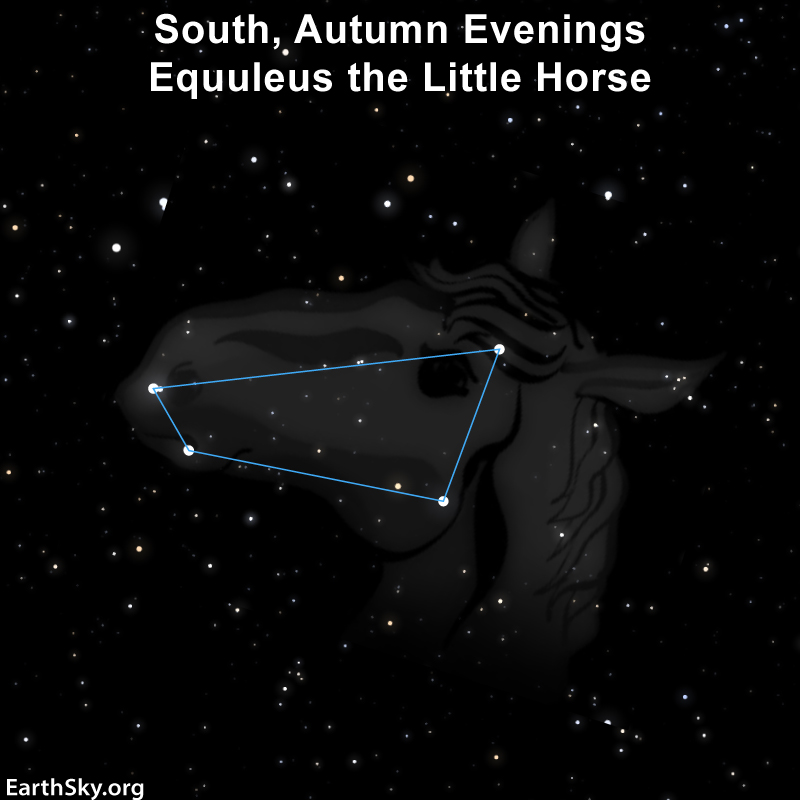
Equuleus the Little Horse is the second smallest constellation in the sky. It’s a good target for the Northern Hemisphere’s fall sky, but only by knowing just where to look. The good news is, if you have dark skies and can find the Summer Triangle, we can lead you to Equuleus, too.
Mythology of Equuleus the Little Horse
Equuleus (pronounced Eh-KWOO-lee-us) was the mythological child of Pegasus the Winged Horse. Although in other mythological stories, Equuleus is Celeris, the brother of Pegasus. Yet another myth says that Equuleus is a sea horse, who came into being when Neptune and Athena were having a contest showcasing their powers. In this story, Equuleus was born from Neptune’s trident.
Location and stars of Equuleus
Because Equuleus is the child of Pegasus, they are located next to one another in the night sky. Pegasus is easy to find if you remember its asterism, the Great Square of Pegasus. Then look between the Great Square and the Summer Triangle to find Equuleus. Another way to find Equuleus is to look under the shape of the leaping dolphin in the constellation Delphinus.
Equuleus is the smallest of all the constellations in the Northern Hemisphere (only Crux, in the Southern Hemisphere, is smaller than Equuleus). It is less than 13 degrees wide at its widest point. Its brightest star is a magnitude 3.92 star known as Alpha Equulei, or Kitalpha. It lies 186 light-years away.
A few other stars in the constellation also have Greek letter designations. Two and a half degrees from Alpha Equulei is Beta Equulei, a magnitude 5.16 star located 360 light-years away. Less than five degrees from Alpha Equulei are two stars in close proximity. The magnitude 4.47 Delta Equulei lies one degree from Gamma Equulei, a magnitude 4.7 star. Delta Equulei is closer at a distance of 60 light-years, while Gamma Equulei lies 115 light-years away. Lastly, the magnitude 5.24 star Epsilon Equulei lies in the western corner of the constellation. Epsilon Equulei is 197 light-years away.

Equuleus’ deep-sky objects
Equuleus’ tiny size away from the plane of our Milky Way means it misses out on nebulae, clusters and other good deep-sky observing targets. Equuleus contains no Messier objects. And you’ll need a hefty telescope to see any of the galaxies here. They’re better targets for a night at the observatory.
Near the center of the constellation is the spiral galaxy NGC 7040 at a magnitude of 15. Less than two degrees away from Gamma Equulei is another spiral galaxy, NGC 7015, with a magnitude of 13. Finally, the barred spiral galaxy NGC 7046 lies in the southern portion of the constellation near some other, even dimmer galaxies. NGC 7046 has a magnitude of 14.
Bottom line: Equuleus the Little Horse is a diminutive constellation that lies south of the Summer Triangle. September nights are a great time to view the Little Horse.
The post Equuleus the Little Horse on autumn nights first appeared on EarthSky.
from EarthSky https://ift.tt/8kLHW36

Equuleus the Little Horse is the second smallest constellation in the sky. It’s a good target for the Northern Hemisphere’s fall sky, but only by knowing just where to look. The good news is, if you have dark skies and can find the Summer Triangle, we can lead you to Equuleus, too.
Mythology of Equuleus the Little Horse
Equuleus (pronounced Eh-KWOO-lee-us) was the mythological child of Pegasus the Winged Horse. Although in other mythological stories, Equuleus is Celeris, the brother of Pegasus. Yet another myth says that Equuleus is a sea horse, who came into being when Neptune and Athena were having a contest showcasing their powers. In this story, Equuleus was born from Neptune’s trident.
Location and stars of Equuleus
Because Equuleus is the child of Pegasus, they are located next to one another in the night sky. Pegasus is easy to find if you remember its asterism, the Great Square of Pegasus. Then look between the Great Square and the Summer Triangle to find Equuleus. Another way to find Equuleus is to look under the shape of the leaping dolphin in the constellation Delphinus.
Equuleus is the smallest of all the constellations in the Northern Hemisphere (only Crux, in the Southern Hemisphere, is smaller than Equuleus). It is less than 13 degrees wide at its widest point. Its brightest star is a magnitude 3.92 star known as Alpha Equulei, or Kitalpha. It lies 186 light-years away.
A few other stars in the constellation also have Greek letter designations. Two and a half degrees from Alpha Equulei is Beta Equulei, a magnitude 5.16 star located 360 light-years away. Less than five degrees from Alpha Equulei are two stars in close proximity. The magnitude 4.47 Delta Equulei lies one degree from Gamma Equulei, a magnitude 4.7 star. Delta Equulei is closer at a distance of 60 light-years, while Gamma Equulei lies 115 light-years away. Lastly, the magnitude 5.24 star Epsilon Equulei lies in the western corner of the constellation. Epsilon Equulei is 197 light-years away.

Equuleus’ deep-sky objects
Equuleus’ tiny size away from the plane of our Milky Way means it misses out on nebulae, clusters and other good deep-sky observing targets. Equuleus contains no Messier objects. And you’ll need a hefty telescope to see any of the galaxies here. They’re better targets for a night at the observatory.
Near the center of the constellation is the spiral galaxy NGC 7040 at a magnitude of 15. Less than two degrees away from Gamma Equulei is another spiral galaxy, NGC 7015, with a magnitude of 13. Finally, the barred spiral galaxy NGC 7046 lies in the southern portion of the constellation near some other, even dimmer galaxies. NGC 7046 has a magnitude of 14.
Bottom line: Equuleus the Little Horse is a diminutive constellation that lies south of the Summer Triangle. September nights are a great time to view the Little Horse.
The post Equuleus the Little Horse on autumn nights first appeared on EarthSky.
from EarthSky https://ift.tt/8kLHW36

Aucun commentaire:
Enregistrer un commentaire